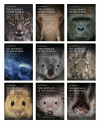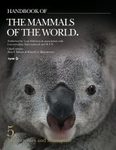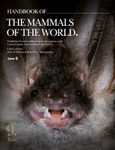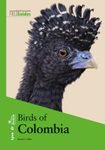By
Gehan de Silva Wijeyeratne
1 Nov 2020
Written for Hardback
This boxed set of two volumes represents yet another scientific and publishing milestone by Lynx Edicions. For the first time in human history, every known extant mammal species is illustrated in a two-volume set. To pick the two volumes up and to know every mammal described to science is in them, is something special. It is hard to think of anyone with a deep interest in mammals who would not want to have these two volumes. For someone who writes and photographs natural history field guides, it is an invaluable reference. I just wish this updated taxonomic work had come out earlier and made my last project,
A Naturalist’s Guide to the Mammals of Sri Lanka a little easier.
The
Illustrated Checklist of the Mammals of the World (ICMW) is a continuation of over a decade of effort that preceded it with the
Handbook of the Mammals of the World (HMW). The HMW was published in nine volumes between January 2009 and October 2019; a span of ten years. The HMW was a massive collaborative effort involving a large team of expert authors and artists working with a fair-sized team of editors and administrative staff. The ICMW draws heavily on the original text and artwork of the HMW, but has been updated as a number of significant changes have taken place in both the number of species described as well as in the taxonomy of mammals.
The species are arranged in a phylogenetic order which represents their evolutionary history. Therefore, it becomes apparent that whales and dolphins are more closely related to deer than horses are to deer. Mammal systematics is discussed in the introductory pages and we learn that the book leans towards a Phylogenetic Species Concept. Volume 1 covers Monotremes to Rodents and Volume 2 covers Eulipotyphles to Carnivores. The ICMW is not just a catalogue of pictures executed to a high standard. There is brief text facing each plate. The text for the species accounts is divided into Orders, Families, Subfamilies, Tribes and Genera. The families are in white text against a shaded bar allowing for easy visual navigation. The front and back inside covers have a visual index to each of the families containing the page numbers as well as the number of genera and species. The text for each species summarises its taxonomy and distribution. Where subspecies are present, the distribution is described at subspecies level. English, French and German names are provided with alternative common English names. The IUCN threat category and the reference to the HMW volume and page number are given. The plates have a distribution map next to each species, with some mammals’ distinctive subspecies also being illustrated.
Much of the design of the book follows the design principles developed in other Lynx titles to enable the reader to navigate and find information easily. However, I am very surprised that unlike in the two-volume
Illustrated Checklist of the Birds of the World and the recent
All the Birds of the World, they did not include the common English name in prominent font next to the scientific name. This does improve the aesthetics of the plates. Many people will find it pleasurable just to browse through the plates and feast their eyes on the remarkable diversity of mammals. However, it is a tad irksome to keep glancing at the text opposite the plates to look up the common name. Another departure from improving the popular appeal of the book is the cover. The cover uses an evolutionary tree which undoubtedly captures the essence of what this publication is about. The downside is that it is rather ‘techy’ and lacks the mass appeal (and hence sales potential) of a stunning cover image as was the case with
All the Birds of the World.
I can only speculate that it may be a conscious decision by the editors and publisher to signal that this is a serious taxonomic work. Perhaps a popular version, an
All the Mammals of the World is yet to come. The taxonomic notes for each species are undoubtedly a key strength of the book. Let me give an example. Because I write field guides, I have a practical need to understand the current status of the Golden Jackal
Canis aureus which has been split based on molecular work, from the African Golden Wolf
Canis lupaster. The concise text (with citations) coupled with the distribution maps makes it all clear very quickly. The taxonomic notes on the African Golden Wolf refer to terms such as ‘nomen dubium’, type specimen and nomenclatural concepts such as the oldest available name. These are not as forbidding as they may seem and the section on nomenclature (page 33) in the introduction explain this clearly in plain language. This section even has the technical terms in boldface to help people who are new to taxonomic terminology. The introduction (pages 23 – 40) is written well, starting with a history on mammal record keeping and an entertaining anecdote on how Oldfield Thomas went on to describe 927 species which are still valid today. The heavily referenced discussion on mammalian phylogeny can be skipped over by the casual enthusiast. But there are good and accessible sections on speciation, species concepts and biogeography. Important taxonomic concepts such as whether a group is monophyletic, paraphyletic or polyphyletic are explained clearly with the use of diagrams.
Presenting it in two volumes helps with handling, but with a combined weight of 6.4 kg, each volume is still rather heavy and not one you would carry in your day pack to read on the commute to work. With over 7,150 illustrations describing 6,554 species in 27 orders and 167 families, this is a remarkable work. Volume 2 in the end sections contains a listing of key references (pages 467 to 477).
With small mammals such as rodents, you expect point endemics confined to very small geographical areas. However, browsing through the book you notice that this can be the case even for large ungulates such as the species of Topi found in Africa. I had not quite appreciated that the Serengeti Topi I had seen in Africa was so range-restricted. The illustrations (mainly by Toni Llobet) are drawn in the photorealism style. They are pleasing to people who have spent a lot of time watching mammals in the wild and like accuracy. However, it is important to be mindful that this is an illustrated checklist as it says on the cover. It is not a field guide and with many of the smaller mammals and the much larger cetaceans, for different reasons, the illustrations in this book cannot suffice as a field guide. Additional illustrations, photographs and text are needed for a field guide. That, of course, does not diminish the joy of being able to have all the world’s mammals in front of you and to idly thumb through, discovering mammals you have never seen before or whose existence you had not been aware of.












































![How to Find and Identify Mammals [Revised Edition]](http://mediacdn.nhbs.com/jackets/jackets_resizer_medium/21/210208.jpg?height=150&width=106)
















